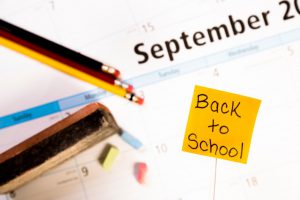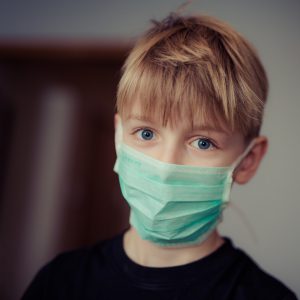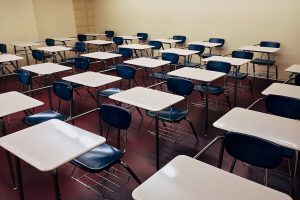The coronavirus hit America hard, forcing much of the country to shut down in mid-March. Schools closed their doors for the remainder of the 2019-2020 school year, and children were forced to continue their education online. Now, as the first day of the school year approaches, school districts across the country are facing the difficult decision of how – and whether – to reopen. The CDC has set safety guidelines for schools to follow, and many states and counties have written out their own plans for reopening based on these guidelines.
Pushing Back Start Dates
The majority of school districts in the country have announced plans to reopen in the fall, but some states are debating pushing back the start of the school year. Two states that have already decided to delay the start of the school year due to spikes in coronavirus cases are Arizona and West Virginia. The governor of Arizona has announced that in-person classes will be delayed until at least August 17th, with schools beginning remote courses before that date. In West Virginia, the governor has indicated that schools won’t reopen in his state until September 8th at the earliest. Some school districts in Georgia and Alabama have also announced that they plan to push back the start of school by one week.
The Blended Approach
Local Boards of Education will determine whether schools are going to fully reopen for in-person classes or whether they will continue with a remote learning model. Some districts are considering the “blended” approach, which would allow students to be physically in the classroom some days and to learn remotely at home other days. As of now, the following districts are planning to implement variations of this approach:
- New York City Mayor Bill de Blasio plans to reopen the nation’s largest school district this fall using a mix of schedules. Most children will be learning in classrooms for 1 to 3 days a week and remotely other days. Classes will likely have no more than 12 people present at a time including teachers and aides. Everyone will be required to wear masks, which will be provided for free.

- Montgomery County, Maryland plans on cutting capacity at schools to 25%. Students will line up outside 6 feet apart, and once they are inside the school, classrooms will only have 12 to 15 students. A more concrete plan will be set by the end of July.
- Columbus City Schools in Ohio will have students in Kindergarten through 8th grade return to school using a blended learning model. Children will attend school two days a week, and spend the other three days engaged in online learning at home. High school students will learn remotely from home full-time for the first half of the school year.
- Illinois school reopening plans consist of different districts creating their own safety plans, as long as they follow certain guidelines. The guidelines require teachers, staff, and students to wear face coverings, prohibit more than 50 people in one space and require social distancing, screening for symptoms, and temperature checks. Buildings will have to be regularly cleaned and disinfected. Schools will have to stagger arrival and dismissal times in order to maintain social distancing. The state will provide free cloth face masks to each staff member and student.
- Florida schools are hoping to reduce their capacity to 25%, in order to give students more space for social distancing in their classroom.
- Virginia schools are monitoring the number of cases before deciding what the fall semester will look like, but they have indicated that they will most likely do the blended format of in-person and online learning.
- Minnesota’s schools might reopen in the fall with strict social distancing guidelines.
- North Carolina has proposed variations that range from students spending half a day at school to students being in school on alternating days or weeks. The governor has said that school districts can reopen with remote-only instruction if they determine that’s what’s best for their community. He has also made clear that if coronavirus cases spike, then the state may switch to requiring all schools to use remote learning.

States like California, and some districts in Georgia and Texas will have school virtually for the first couple of weeks. - California has seen new infections surge in recent weeks, causing a debate on whether school should reopen in the fall. Its two largest school districts, Los Angeles and San Diego, will not open for any in-person schooling; students will learn remotely full-time in the fall.
- Atlanta public schools in Georgia will have students attend the first nine weeks of the school year virtually.
- Houston Independent School District in Texas will begin the school year on September 8th completely remotely, and will begin in-person instruction on October 19.
- Texas Public Schools have not officially released any public health guidelines, but as of now, the plan is to have all students return to their school buildings, even as cases continue to spike. Education officials released final guidelines saying that districts can choose to provide live virtual schooling or schooling that is not delivered in real time, including pre-recorded video lessons or paper assignments. The state will not penalize school districts for major decreases in student attendance for the first 12 weeks of the school year.
- Public schools in Tennessee are not returning to in-person learning on their opening day of August 4. Instead they will only offer remote learning until at least Labor Day.
- Pennsylvania Philadelphia Independent School District plans to reopen schools in September with a hybrid of in-person and online learning. Other counties in Pennsylvania have adapted this plan as well, with most students physically attending school at least 2 days per week. Some school districts are giving parents the option of whether they want their children to go to school physically or to learn remotely full-time.
Northampton School District’s superintendent presented a plan in which Kindergarten would be half-day, elementary school students would have four days of in-person school, and secondary students would have some in-person instruction daily. High school students would be divided into two groups, each of which would spend part of the day at school, overlapping for several hours.
East Penn School District will have middle and high school students on a hybrid schedule of 2 days in class and 3 days at home. Elementary students will return full-time but masks will be required, class sizes will be reduced, and children will be required to be 3-6 feet apart.
- Seattle schools in Washington are currently planning for a minimum of two days of in-person instruction per week for all Kindergarten through 12th grade students. The Seattle public school board is also offering a 100% remote plan for families who are not comfortable sending their children back to school.

Classrooms will be disinfected daily. - New Jersey’s governor has said that each district in his state will develop a plan that best fits the district’s local needs. The following guidelines will apply to all schools: faculty and staff will wear face coverings and students will also be encouraged to wear face coverings and practice social distancing. The schools will be sanitized daily and temperature checks will be required. School buses will seat one student per row skipping a row between each child if possible. Cafeteria meal times will be staggered. If there is not enough room to keep students six feet apart in classrooms, districts are encouraged to install physical barriers between desks and make sure all desks face the same direction.
- New Hampshire’s governor announced that he will let schools make the decision to reopen for themselves. The guidance put out by the state encourages schools to develop plans for both in-person and remote learning for those who choose not to return for health reasons.
- South Carolina’s governor announced that public schools must be available for in-person instruction this fall, but virtual learning will be an option for parents that do not feel comfortable sending their kids to school. He said parents should be able to decide for themselves whether to send students to school or to keep them at home.
- Mississippi will follow a hybrid model, as well, with a combination of online and face-to-face instruction. Some counties like Canton will have children be physically present 2 days per week (either Monday & Thursday or Wednesday & Friday) and learn from home virtually three days a week. The first day of school will remain August 10th. Some private schools are planning to have children return to in-person schooling full-time.
- Connecticut’s governor has said that students will return to their classrooms 5 days a week this fall. Connecticut has had one of the lowest infection and hospitalization rates in the nation. Because of this, schools will be open this fall with social distancing between student work spaces “when feasible.” Class sizes will be smaller to accommodate social distancing guidelines, and masks will be required for all students and staff.
In order to come up with these plans, many counties sent surveys home to parents asking what they were comfortable with in regards to school reopenings. The list above is by no means exhaustive: some counties are still drafting plans to be submitted to their states. In addition, in most cases, these guidelines only apply to public schools. As of now, many private schools plan to have students attend school full- time in the fall.
The coronavirus has turned everything upside down for schools, parents, and children. Decisions about how to return safely to school can be especially difficult for working parents who want the best for their children, but who also can’t stay at home to teach their children remotely. No matter what the reopening plan is for each state or school district, it will be a tough adjustment for both parents and children.
